Trackin' Bracken: A father and son story
emerges in Switzerland County, IN
Dateline: July 19, 2015
Updated: 22 Nov 2015
Your host: David Carnes;
U.S. Navy veteran
Evansville, IN, native
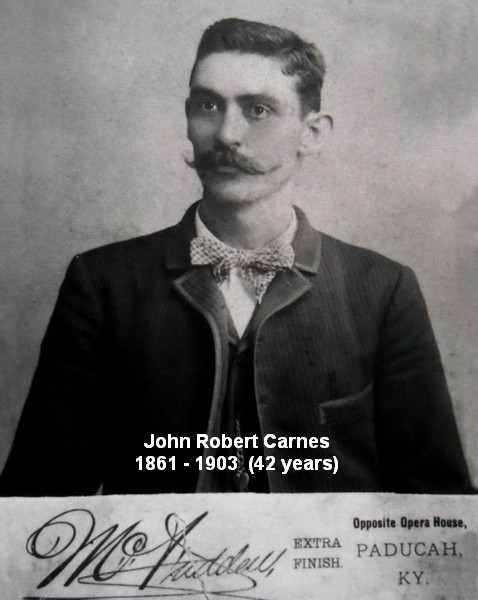
The central character of this story is my great great grandfather James Bracken Carnes (hereafter Bracken ). In this story I attempt to flesh out his life with limited information: to track his steps from his days as a young husband and father in Crawford County, IN, and onto the ram steamboat USS Switzerland, circa several months after the fall of Vicksburg in the midst of the American Civil War; I include a short interlude on the Ellet family to give context to Bracken's particular military service; then cobble together what I know of his life's pursuits after the war up to his final days in Cairo, IL.
The story begins in the town of Vevay in Switzerland County, IN, with Bracken's son, my great grandfather Captain John Jack Robert Carnes (hereafter Captain Jack ). I didn't know much about Captain Jack when I first visited Vevay in October 2014. From childhood I had been told he was the owner of a steamboat and lived in  Golconda, IL, but little else. There, hanging in my father's office, is a photo of his packet steamboat the Charles B. Pearce (hereafter Golconda, IL, but little else. There, hanging in my father's office, is a photo of his packet steamboat the Charles B. Pearce (hereafter CBP ; Pearce is misspelled Pierce in that photo). Written on the photo was Our boat .
When I first learned there was a model of the CBP residing in Switzerland County, then later learned Captain Jack's father Bracken had served aboard a naval vessel built and named by two residents of Switzerland County, it all made for a very tidy starting point for this story. I devote one chapter to Bracken's father, Alexander Carnes, one of the early settlers of the town of Fredonia in Crawford County, IN.
This story, though, is not meant to be a Carnes family story alone. The paternal side of my family grows out of a larger American story of westward expansion, manifesting in the land offices of the newly-minted state of Indiana. At certain junctures I'll necessarily have to engage in informed speculation to move the narrative along, but for the most part I conjecture within established fact. I've included a bibliography as reference so you won't think I'm whistling Dixie on my Civil War accounts.
Join me as I attempt to corral these three paternal bulls in my pen, fence them in with facts, and explore my paternal pedigree and their progeny through... trackin' Bracken.
Captain Jack: the son
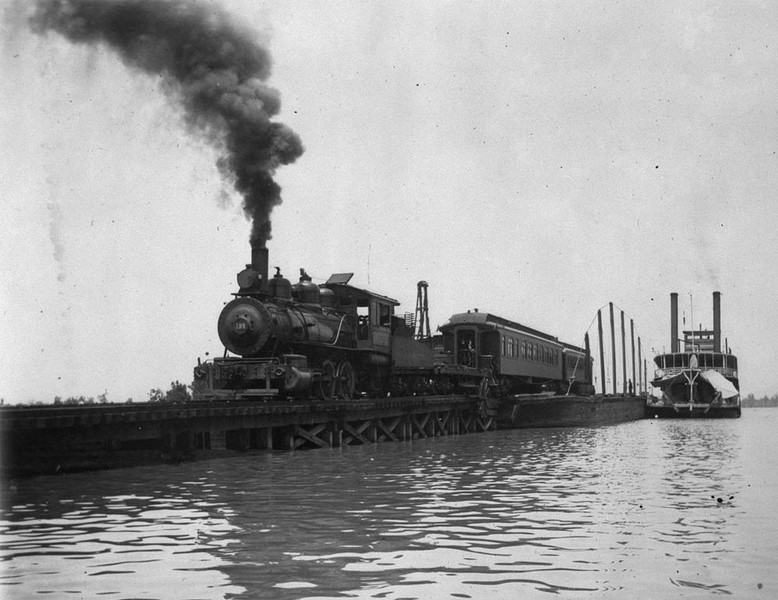
At the Life on the Ohio History Museum in Vevay there is a permanent exhibit of twelve model steamboats made by Switzerland County native Harold Patterson. The models are beautifully displayed behind glass, replete with accent lighting, giving each model a sort of jewel-box quality. They are veritable freeze-frames of a bygone era in river life. The detail on the models is really quite impressive.

One of the models on display is the CBP, a stern-wheel packet steamboat, once co-owned by my great grandfather Captain John "Jack" Robert Carnes and his partner Captain Otto Bauer. The CBP was built by Capt. George B. Edgington in 1899 in the town of Augusta in Bracken County, KY. Captain Jack owned two other steamboats before the CBP: the towboats Dick Clyde and the Woolfolk. He and Otto bought the CBP in June of 1903, running Cincinnati - Portsmouth briefly, but Captain Jack died later that same month.
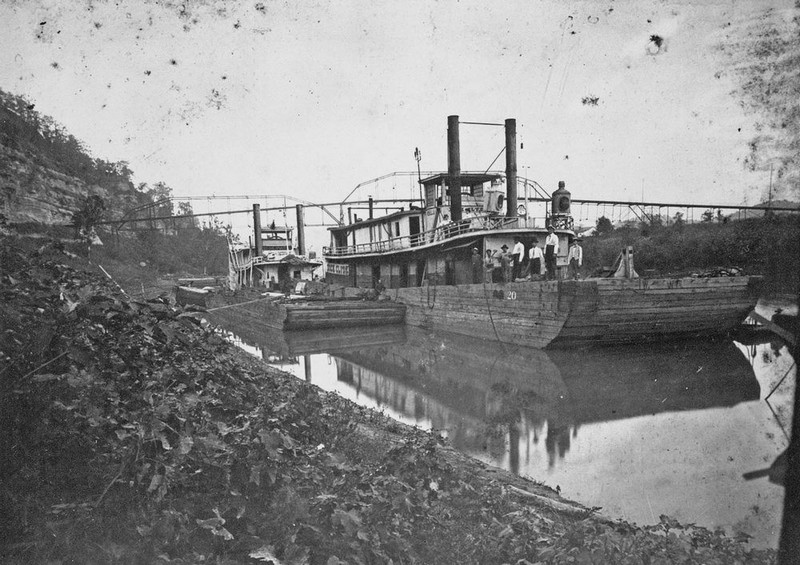 Otto retained ownership of the CBP for about a year, after which he sold her to owner Augustus French and his wife, Captain Callie French, one of the few female licensed pilots at the time on the Mississippi and Ohio Rivers. The CBP was at one time the sole towboat for French's New Sensation showboat. In February 1918, while moored at the Enterprise Docks in Pt. Pleasant, WV, the CBP overturned and was lost in the harsh Ohio Valley winter of 1917/18. Otto retained ownership of the CBP for about a year, after which he sold her to owner Augustus French and his wife, Captain Callie French, one of the few female licensed pilots at the time on the Mississippi and Ohio Rivers. The CBP was at one time the sole towboat for French's New Sensation showboat. In February 1918, while moored at the Enterprise Docks in Pt. Pleasant, WV, the CBP overturned and was lost in the harsh Ohio Valley winter of 1917/18.
Steamboats were named by their captains and/or owners and it has been a matter of speculation in my family just where the CBP's name came from. Charles B. Pearce was an actual person, a prominent banker in Maysville, KY, for over forty years. He organized the private bank Pearce & Wallingford, of which he later became sole owner, and converted it into the State National Bank of Maysville. I am left to imagine that perhaps Pearce financed Edgington's building of the CBP in 1899.
Bracken: the father

Bracken was a native of Leavenworth, IN (as was Captain Jack). He married Amanda King on 24 Nov 1854 in New Amsterdam, IN. During the Civil War, Bracken actively served the Union's cause on both land and water. Captain Jack, born 04 Jan 1861, was but an infant in the first year of the war, having two older sisters, Elizabeth and Kate. Bracken would father another daughter, Harriet, during the war, and one more, Belle Z., just after it ended.
Bracken was commissioned a captain in the Indiana Legion, Sixth Regiment, serving in the Scott Guards (Harrison County, IN), and saw action in repelling Confederate 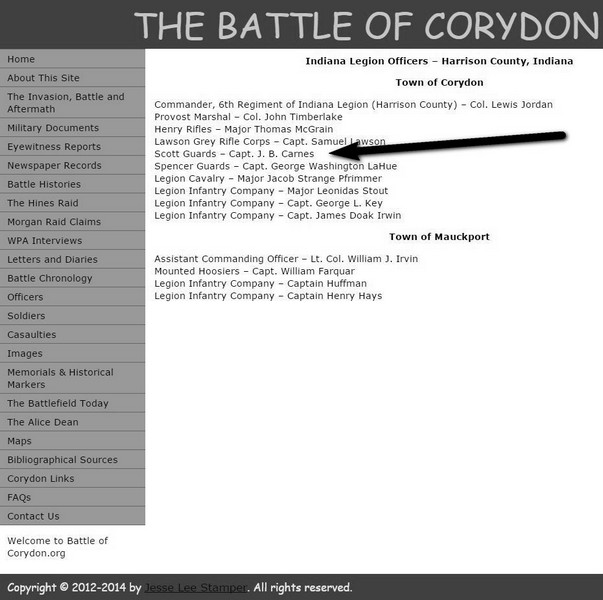 incursions into Crawford County during Hines Raid (17 June 1863). Read the Brandenburg account of Hines Raid. The 'Captain Carnes' so cussed by Confederates in that story is Bracken. incursions into Crawford County during Hines Raid (17 June 1863). Read the Brandenburg account of Hines Raid. The 'Captain Carnes' so cussed by Confederates in that story is Bracken.
He would eventually muster out of the Scott Guards and by 15 Oct 1863 enlist in the Mississippi Marine Brigade (MMB), serving in that unit aboard the USS Ram Switzerland as a 1st Class Pilot until 19 June 1864. The Switzerland was built by Vevay residents and biological brothers U.P. and Jules Schenck and named for their native country, Switzerland. At the commencement of the Civil War she was purchased by the US Quartermaster Department and outfitted as a ram steamer for service in Charles Ellet, Jr.'s Ram Fleet.
What inspired the name Bracken ?:
It's not every day I meet someone, living or dead, with a middle name of Bracken. Where did the name come from? A look into the ephemeral life of Bracken's father, Alexander Carnes, provides hints.
Alexander Carnes remains one of the more elusive ancestral characters in my studies. A Google search of him yields little. I came upon his name indirectly while conducting a search for Captain Jack's vital statistics in a Pope County (IL) marriage registry. There were two key bits of information which opened a slew of patrilineal leads: 1) Captain Jack's birthplace (Leavenworth, IN); and 2) his parents' names: father James B. Carnes and a mother with a maiden name of King; until I learned her first name, I referred to her as Lady King. While trolling online genealogical databases for Bracken's ancestry one day, I came upon his father's name: Alexander! Various ancestry web sites list Alexander as having been born in either 1790 or 1807 and in either England or Delaware... some help, eh?
It is in Crawford County, IN, (CC) where Alexander Carnes's life takes shape on paper. He married Nancy Samuels there (documented) and made land purchases in the Town of Fredonia, IN (documented) during the young, heady days of the newly-formed state of Indiana. He purchased land from a man named Reuben Thom, a fixture in the Fredericksburg,  VA, community and one of early holders of land patents in the state of Indiana (land patents were contracts made between the federal government and a private individual; land deeds were contracts of sale between two private parties) VA, community and one of early holders of land patents in the state of Indiana (land patents were contracts made between the federal government and a private individual; land deeds were contracts of sale between two private parties)
Land deeds in the 1820's in the Town of Fredonia clearly show an Alexander Carnes (notice spelling of surname) among its earliest purchasers of land. Also mentioned in county land deeds are a John Carnes (possibly his brother, but not to be confused with Alexander's oldest son John); and a William Carnes, also a possible brother of Alexander's. Alexander, John and William all recorded land purchases in CC and did business with the aforementioned Reuben Thom through his brother/agent, Allen Thom.
An Alexander Carnes is also listed in the Executive Proceedings of the State of Indiana, 1816-1836, as contesting the elections of Crawford County clerk/recorder and Crawford County sheriff in 1824-25. He is also listed as a Carnes in two circuit court documents in September 1825 and March 1826 in which he is a defendant charged with inciting riots (charges were dropped).
But on from this, further CC documentation on Alexander serves only to confuse his identity. The CC Census of 1830 lists an "Alexander Kearns" (neither his own nor his parents' birthplace are listed) with a "John Kearns" listed next to him. It would convenient to assume Alexander Carnes = Alexander Kearns, but a genealogist worth his salt does not assume, he/she endeavors to prove.
Alexander Kearns family profile matches exactly that of other Alexander Carnes family profiles:
"2 x white males under 5 years of age (his infant son Bracken and oldest child John); 1 x white male between 20 and 30 years of age (Alexander himself); 2 x white females under 5 years of age (daughters Elizabeth and Delilah); 1 x white female between 20 and 30 years of age (his wife Nancy)"; Sarah Jane Carnes, Alexander and Nancy's youngest child, was born in 1832 in Missouri (all other of their children were born in Indiana).
If Alexander Kearns is Alexander Carnes, it's a curiosity to me just why the spelling of his surname changed between 1825 and 1830... it could have been a clerical error, it could have been intentional. Remember: he is listed as a 'Carnes' in official county documents from 1824-26 (marriage certificate, land deeds, court documents). Had he worn out his welcome in CC as an indicted inciter of riots (to be fair, possibly he was just an ethical political activist who had uncovered questionable election practices), adopted an etymological precursor for his surname from his forefathers' native Ireland or Scotland, then set out for Missouri to start a new life, sire Sarah and die there?
Alexander's Delaware connection is seen in later CC census reports in the household listings of his children: i.e. the father of John, Delilah, Elizabeth, James and Sarah  Carnes is from 'Delaware' (not England) and their mother (Nancy) from 'Kentucky'. I have searched, so far in vain, for some record of Alexander's existence in the Delaware State Archives. Carnes is from 'Delaware' (not England) and their mother (Nancy) from 'Kentucky'. I have searched, so far in vain, for some record of Alexander's existence in the Delaware State Archives.
A thin lead came to me recently (thank you Mary Murphy) in the form of baptismal records of a William and John Kearns, baptized in Immanuel Church, New Castle County, DE. Their parents are John and Mary Kearns (possibly my paternal great-great-great-great grandfather and GGGGGM, respectively). William was baptized at 1 year-old on 10 Mar 1791; John at 4 months-old on 03 Jun 1792. Two Kearns females in CC, IN, censuses, a Margaret and an Elizabeth, also hail from Delaware and are contemporaries of William, John and Alexander.
The strongest case for all of them being siblings is circumstantial, but still possible. The search for a documented connection between them all, as siblings, continues.
Alexander most likely came to Indiana for the same reasons multitudes from the East did: he was lured west by the prospect of being able to buy available, affordable land in the newly-opened Northwest Territory, Indiana being the first state to be carved out of that Territory. I can only speculate as to how he got there.
Let's look at some of the well-traveled westward roads in his day:
The first overland turnpike to be laid in the Delaware colony originated in New Castle, DE (then the capital of the colony), and headed toward the 'Chesapeake River' (Susquehanna?). This turnpike was a central trading route for goods and passengers going out of and coming into Delaware. At the furthest reaches of this Delaware turnpike, Alexander could have continued on one of several roads leading to various cities along the Ohio River. Braddock Road was a well-known westward route, but it was used mostly for military purposes. The National Road might have been a more likely path as it was wide enough for wagons. Once at Wheeling or Pittsburgh, he could have boarded a flatboat and floated downriver toward Harrison County, IN, to begin his new life.
Below are a few of the more well-known trans-Appalachian roads leading to the Ohio River Valley:
Braddock Road: Cumberland (MD) to Ft. Duquesne (Pitt)
The National Road: Cumberland (MD) to Wheeling
The Pennsylvania Road: Philadelphia to Pittsburgh
The Wilderness Road: Philadelphia, down the Shenandoah Valley, to Bristol, west through the Cumberland Gap (KY), terminating in Louisville.
I think it worth mentioning that Indiana was a federal-land state, meaning that unclaimed land was surveyed, then granted or sold by the federal government through federal and state land offices. There were two areas excepted under "federal -land" status: 1) lands around Vincennes which were settled by the French and 2) land around Clarksville which was deemed the George Rogers Clark Grant. As I mentioned earlier, the sale of a piece of land from the federal government to an individual was called a land patent, the first owner of that land called the patentee.
Below are listed early Land Offices in Indiana:
Cincinnati, OH: sales of public land by the US Government in Indiana began in 1801 out of this office
Vincennes: first land office in Indiana, 1807; office discontinued in 1861 and unsold lands were attached to Indianapolis Land Office
Jeffersonville: opened in 1808; office discontinued in 1855 and unsold lands were attached to Indianapolis Land Office
Brookville: sales here began in 1820; moved to Indianapolis in 1825; made its final sale in 1876
Terre Haute: this office was moved to Crawfordsville in 1823; closed in 1853; unsold lands were attached to Indianapolis Land Office
Fort Wayne: office opened 1823; final sale: 1852; all unsold lands attached to Indianapolis
La Porte: opened in 1833; office moved to Winamac in 1839; sales ended 1855 and unsold lands were attached to Indianapolis Land Office
A unique underpinning to land sales in Indiana, compared to earlier methods of surveying and land sales, was the fact that an east-west baseline and the north-south 2nd Meridian, surveyed and established in Indiana by Ebenezer Buckingham under the Ordinance of 1785, were used to govern all subsequent land surveys in that state, to include the drawing of counties,townships, property lines, etc. As a result, buyers of land anywhere in Indiana would have a common reference line when establishing their own property lines. This was an improvement upon the previous, confusing British surveying system of metes-and-bounds to determine property lines.
So, with the War of 1812 over by the time Alexander shows up in Indiana (not exactly sure of the year he arrived), with the Native American population in Indiana either checked, treatied or cheated, and with the Indiana capital of Corydon established and near a major U.S. Land Office at Jeffersonville, IN, all the necessary administrative and legal infrastructure was in place and conveniently close by for prospective land buyers to come out, buy land and have those purchases recorded and on file.
We've probably all heard the story of Thomas Lincoln who brought his family up from Kentucky to Spencer County, IN, largely because of the difficulties he encountered buying land in Kentucky stemming from a confusing surveying system and a lack of legal recourse over disputes of property lines. The Thomas Lincoln family is but one example of the draw the survey system in Indiana had.
I started this chapter asking 'what inspired the name Bracken'. William Bracken was a hunter, tradesman and surveyor who explored Kentucky in the 18th century. Bracken County, KY, was named after him. Alexander and Nancy must have been inspired by William Bracken's explorations enough to make their son his namesake. Alexander and Nancy's youngest, Sarah, and her husband Robert Pleasant went one better: they named their first child William Bracken Pleasant.
First questions of Bracken

A year prior to my writing this story I didn't even know this man named Bracken existed. Since my discovery, I've gathered some tidbits which, put together, give a glimpse of a father making the best of it in a time of civil war.
I have no photos of him. His medical files say he was 6' 1/2 inches tall, 165 lbs at the age of 61. He filed for a navy pension in July of 1891, five months before he passed away. I have no letters nor a diary which might give insight into his manner of thinking. I did find a letter through the Abraham Lincoln Presidential Library in Springfield, IL, written by the Assistant Surgeon in Command of the U.S. Marine Hospital in Cairo, IL, and sent to Bracken's wife Amanda on the occasion of his death, asking her what she would like to do with her husband's remains.
So, from his Navy pension records, some copies of Crawford County land deeds, a marriage certificate, his affiliations and associations and a few history books describing one of the military units he served in, I crudely cobble together the story of this man's life.
As I read through his Navy pension records I saw he had served aboard the USS Ram Switzerland. Written on a number of pages in his files were the initials M.M.B. U.S. Vols . Never were the letters M.M.B. (MMB) spelled out, a thing I thought strangely cryptic for an administrative document. One day while reading about the ram Switzerland I came upon what those initials stood for: Mississippi Marine Brigade . What was the MMB and what was their mission?
Charles Ellet, Jr. and the Mississippi Ram Fleet
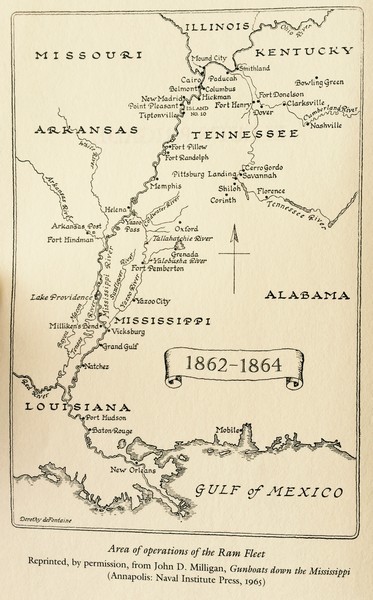
Charles Ellet, Jr., was a civil engineer from Philadelphia who designed some of this country's first important suspension bridges, three very well-known ones being at Philadelphia, Wheeling, WV, and Niagara Falls. He also developed plans for flood control to improve navigation of this nation's rivers. It just so happened he was also an energetic, unpurchasable supporter of the Union's cause with a particular interest in naval warfare.
Ellet had for years attempted to sell the U.S. Navy on the idea of building expendable ram steamboats for attacking enemy vessels, but his ideas fell on deaf, proud ears in Washington. His ideas had a rapt audience in Richmond, ironically enough. Confederate Secretary of War Judah P. Benjamin obtained an appropriation of $1m to outfit fourteen steamboats as gunboat rams, to man them and to organize for the defense of New Orleans.

Back in Washington, Union Secretary of the Navy Gideon Welles condescended to Ellet's ram idea as a useless instrument of war. It would take the menacing presence of the Confederacy's CSS Virginia, an ironclad kitted out with an iron prow for ramming, to nudge Lincoln and his cabinet to come around to the value of Ellet's notion. The events of March and May 1862 at Hampton Roads, in which the CSS Virginia demonstrated the havoc it could wreak against weaker wood-hulled warships, would frighten leaders in Washington enough to come running to Ellet's plan. Ellet's biggest sponsor in Washington was U.S. Secretary of War Edwin Stanton.
Stanton gave wide berth to Ellet to execute his plan and he immediately began casing the Ohio River and its tributaries from Pittsburgh to Cincinnati to New Albany, IN, for steamboats capable of being outfitted for ram duty. He selected nine. One of them was the Switzerland, docked at Madison, IN, when he discovered it. Stanton authorized its purchase for $13,000.
In addition to scouring the river banks for steamboats to press into ram service, Ellet scoured the surrounding communities for men fit to operate these rams. I borrow from Hearn's book:
"Ellet informed Stanton that as soon as boats were ready he intended to go down to Island No. 10 or any other stronghold of the rebels... and run down before the batteries and drive our rams at full speed into the rebel boats... the men must take service with the full knowledge of the dangerous nature of the duty... I prefer daring and skillful river men, if they can be got, to handle the boats"
Hearn mentions some deal sweeteners used to recruit men for the Ram Fleet:
Ellet asked for certain commitments from Stanton for his crew, suggesting that "since the men would be civilian volunteers they be paid Mississippi River wages with extra allowances for hazardous duty".
Ellet then "proposed an elaborate scheme for determining bonus money -- an extra month's pay for every fortified position passed and prize money for destroying the enemy's floating war property"
Ellet did not want to lose directional control of the Ram Fleet to U.S. Navy Flag Officer Andrew Foote nor be dissolved into Foote's already-existing Mississippi flotilla based in Cairo, IL. He already had volunteer captains and river boatmen for crew and privately wanted his fleet to remain under civilian control. Civilians hired by Ellet were not sworn into the service, rather signed a Military Obligation for six months. Bracken enlisted about a year after Charles Ellet, Jr.'s death. Some administrative and personnel changes had occurred in the Ram Fleet command, so I'm not sure of the contract Bracken agreed to.
Unlike the Confederate rams, the Union rams were not initially armed with big guns. They had sharpshooters aboard with rifles, yes, but not deck cannons like their Confederate counterparts, making the Ram Fleet's ramming mission all that more risky for those aboard. They were going headlong into a gunfight with inferior firepower... but not inferior will.
The Battle of Memphis: the death of Charles, the birth of the MMB
Memphis was the first test for Ellet, Jr.'s Ram Fleet and his plans and performance proved very effective. On the morning of 06 June 1862, through patchy river fog, Ellet, Jr, as captain of the ram Queen of the West, and his brother Alfred as captain of the ram Monarch, steamed past the overcautious U.S. Navy flotilla idling just north of the city and toward Montgomery's column of eight Confederate rams, while the citizens of Memphis lined the banks to watch. It was Charles Ellet's quick strike at the gut of the Confederate ram column which had Montgomery reeling and in disarray early, possibly foiling his plans for a more set-piece naval battle.
In two hours time, the majority of the Confederate rams were either destroyed or listing and scattered about the river. They would not be a serious menace on the Mississippi or its tributaries for the rest of the war. At one point as the Union ram fleet advanced, Ellet stood upon the hurricane deck of his Queen of the West between his two pilots, urging full steam, and rammed the CSS Lovell so hard it got stuck in her side. While sharpshooters aboard were locked in close-range shooting with the crew of the Lovell, the CSS Beauregard came from another direction and rammed the Queen of the West, knocking her loose from the Lovell. As Ellet came out of the pilothouse to inspect the damage, a rebel pistol ball caught him just above the knee. He would live only two more weeks after that shot.
 Too injured to go ashore himself to demand surrender from Memphis Mayor John Park, Ellet, Jr. sent his son, Charles Rivers Ellet, along with Lt. Warren Crandall (future biographer of the MMB) and two marines from the 59th Illinois, Sergeant William McDonald and Private Cyrus Lathrop, to deliver the ultimatum. Charles Rivers Ellet demanded he be allowed to raise the Stars and Stripes over the customhouse and post office as emblems of the return of your city to the care and protection of the U.S. Constitution.
Charles Ellet, Jr was the lone Union casualty at the Battle of Memphis, a small price to pay for victory, according to his Kamikaze mind set. It would be left to Ellet, Jr.'s younger brother Alfred to carry the torch of his brother's Ram Fleet forward.
Ram Fleet dissolves into the MMB
The Ram Fleet had always operated somewhat in secret, thanks to back room maneuvering of Secretary of War Stanton, and neither Navy nor Army brass liked that. After Ellet, Jr.'s death, Stanton kept the Ram Fleet under his protective wing and placed Alfred Ellet in charge of daily matters. Lincoln allowed Stanton some administrative wiggle room in keeping the ram fleet together, but put stipulations on command structure: Alfred Ellet would take orders from U.S. Navy Flag Officer Charles Davis, the very officer he and his brother steamed past without permission at the Battle of Memphis. Alfred had no particular interest in the Ram Fleet and no particular love for Davis.
While waiting for Stanton and Welles to reach a decision on where to place the Ram Fleet, Alfred established communications with Admiral David Dixon Porter, commander of the Mississippi Squadron, and pitched the idea of forming a mobile marine force to deal with rebel guerilla attacks along the river. Porter's commanders knew these rebel bands were indeed a threat to open river commerce and passage, thus Porter was not averse to the idea.
So, on 01 Nov 1862 Lincoln signed Alfred Ellet's appointment to Brigadier General and Stanton invited his new Brigade commander to Washington for a conference. Charles Rivers Ellet, Alfred's nephew, was elevated to second-in-command of the Ram Fleet. Charles Rivers took care of matters involving the Ram Fleet, which would serve the MMB, allowing the Brigadier General to focus his efforts on the care of his newly-formed Mississippi Marine Brigade (MMB). The Brigadier General asked that Captain Warren D. Crandall (later to be the primary biographer of the MMB along with Isaac Newell), who had commanded the ram Lioness, be made Assistant Adjutant General and reassigned from the 59th Illinois Infantry. Stanton agreed and Crandall was immediately sent to St. Louis to open a recruiting office. It was Brig. Gen. Ellet's intention to recruit enough artillery, infantry and cavalry soldiers, combining them with the existing Ram Fleet, to bring an end to rebel guerilla activity wherever it sprouted along the rivers.
Why did Bracken go with the MMB?

As stated earlier, Bracken was a husband and father of three children by the time he gained his commission on 15 Nov 1862 in the Indiana Legion, Sixth Regiment. By the time he enlisted with the MMB, he had a fourth child by wife Amanda King. A fifth child would arrive a year after the war ended, thus the Bracken family tally by 1866 was: one husband, one wife, four daughters, one son (Captain Jack).
Were the financial inducements to enlist in the MMB that enticing? Was Bracken that devoted to the Union's cause that he wanted to jump into the breech of federal service? Did the MMB represent a more interesting assignment or just less risk than duty with the Indiana Legion? I have no reason to believe that Bracken enlisted in the MMB because of economic hardship (see my After the War chapter). I'll explain why I say this:
His older brother John Carnes was a successful river trader and merchant in Leavenworth with a fleet of flatboats. John is the subject of a booklet written by the Crawford County Historical and Genealogical Society, based largely on three leather bound flatboat journals kept by him over the years.
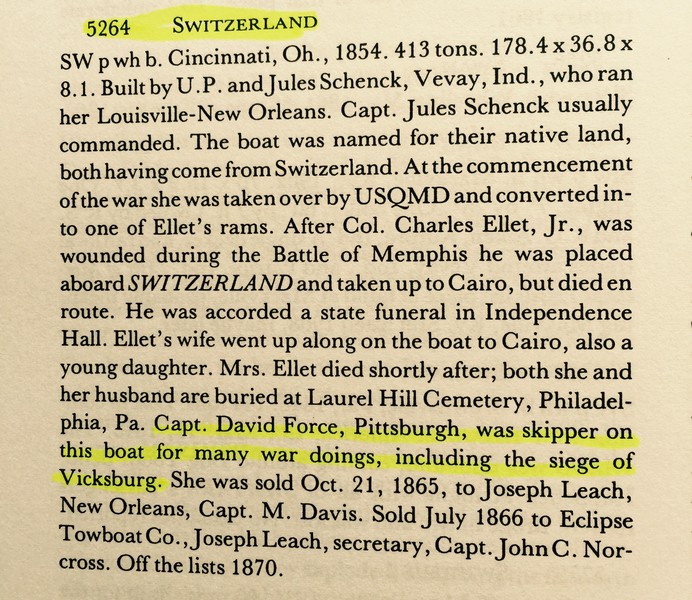
The journals are marked Book I, Book II and Book III.
Book I covers the years 1855-57. In that book are listed several transactions between brothers Bracken and John. Thus, it looks as though Bracken engaged in some river trading independently or maybe was just employed by his older brother. As you read through John's journals, you'll see reference made to places such as Caseyville, KY, Cairo, IL, Island No. 10 and Paddy's Hens and Chickens, that cluster of islands in the Mississippi River near Memphis, TN. This indicates these two men were very familiar with stretches of the Ohio and Mississippi Rivers from Louisville to Memphis. I think back to what Ellet told Stanton "I prefer daring and skillful rivermen, if they can be got, to handle the boats". Both brothers would have fit Ellet, Jr's bill for skillful rivermen.
Book II covers the years 1856-61. During the war, robust private river commerce was brought to a standstill. I don't see Bracken's name listed in Book II, so I'm inclined to think he was cubbing on a steamboat somewhere, gaining valuable experience which positioned him well as a candidate for pilot aboard a war vessel. After all, steamboat piloting is a profession that takes years to master, if one ever really does master a boat and a river, and Bracken had to, at some point prior to the war, gain experience worthy of guiding a war vessel through riverine rigor on risky military expeditions.
Literary fodder: did ever the twain meet?
I read Mark Twain's Life on the Mississippi in college. I enjoyed it so much I've re-read several times. After starting my genealogical work, though, this book became more than just an enjoyable read: it became pertinent to my patrilineage.
Samuel Clemens earned his steamboat pilot's certificate on 09 April 1859. He and Bracken would have been contemporaries in the trade. Did they ever pass each other on the Ohio River, beknownst or unbeknownst? It is documented that a twelve-year-old Clemens took passage aboard the steamer Paul Jones from Cincinnati to New Orleans (circa 1847). That trip would have taken Clemens by Leavenworth, IN. Bracken would have been 17 years of age in 1847. Bracken was listed as a farmer in the 1850 CC census; his brother John was listed as a boatsman .
Twain describes the pilot type in Life on the Mississippi:
"all pilots are tireless talkers, when gathered together, as they talk only about the river... your true pilot cares nothing about anything on earth but the river, and his pride in his occupation surpasses the pride of kings"
Twain references wages and certification:
"For a long time wages had been two hundred and fifty dollars a month; but curiously enough, as steamboats multiplied and business increased, the wages began to fall little by little. It was easy to discover the reason for this...too many pilots were being made ... all pilots and captains had sons or nephews who wanted to be pilots... when a steersman had made a progress that was satisfactory to any two pilots in the trade, they could get a pilot's license for him by signing an application directed to the United States Inspector. Nothing further was needed; usually no questions were asked, no proofs of capacity required"
If you want to get an idea of the rigors faced on the river, read in Life on the Mississippi the chapters A Pilot's Needs , Rank and Dignity of Piloting and The Pilot's Monopoly . These chapters also make mention of the inbred cultivated royalty of the steamboat pilot fraternity.
In A Pilot's Needs Twain mentions the faculties of memory and unresting observance as two important tools a pilot must possess to keep current of the ever changing shapes of islands, bars, points and bends in the river. A steamboat ride was hardly a dreamy romantic float for a pilot, but rather a demanding exercise in reading the face of the water , which gave indication of the shape of the river bottom and all submerged dangers below. A pilot had to be familiar with the river going upstream and down, both in sunlight or moon light... or neither.
It is left for us, the uninitiated, to over-romanticize river travel, or so Twain suggests.
1863, Q1
After his brother's death, Alfred Ellet did not have an easy time getting the MMB together. He experienced recruiting difficulties and was desperate enough at one point to ask General Halleck for permission to enlist convalescents recovering in St. Louis hospitals. Stanton approved this, believing that men unable to march could still serve effectively on boats. Recruiting became the primary responsibility of Warren D. Crandall. Recruiting handbills were distributed as far east as the Department of the Ohio. Of course, by then, Bracken was a riverboatsman. Good and bad news traveled fast along the river. I have no reason to believe Bracken was a convalescent going into service with the MMB.
One recruiting handbill read like this:
Mississippi Marine Brigade,
soldiering made easy,
no hard marching, no carrying knapsacks.
There will be but very little marching for any of the troops.
They will be provided on the boats with good cooks and bedding.
Another like this:
The proposed service is especially attractive to old soldiers.
It has the following advantages:
1. There are no trenches to dig
2. There are no rebel houses to guard
3. There is no picket duty to perform
4. There is no danger of camps in the mud, but always a chance to sleep under cover
5. There is no chance of short rations.
6. The command will always be kept together. Not everyone was so enticed by the $100 enlistment bonus offered nor the peculiar service being advertised for this newly-formed MMB. In February 1863 Stanton solved Ellet's manpower shortfall by transferring to the MMB men of the 59th Illinois, 63rd Illinois and Company K of the 18th Illinois (then attached to the Ram Fleet). When a sufficient number of men had been assembled they were put up in the Benton Barracks on the Fair Grounds in northwest St. Louis and began drilling.

Generally, an MMB enlistee signed on for three years. This created problems later when the MMB dissolved, for the unit was not in existence longer than three years. I do think Bracken came in under a shorter contract, possibly one along the lines of the Military Obligation as proposed by Charles Ellet, Jr. to his original Ram Fleet recruits, for I don't see anything in his naval records suggesting he had an administrative battle to be released of MMB duty. Or he was just re-assigned to another ship (the Naiad and Grosbeak) and served out his remaining contract or waited until the war ended, whichever came first.
Interjection:
Bracken is listed in Hewett's Roster of Union Soldiers, 1861-65 for Missouri:
Carnes, James B., 1st St. Mil. Cav. Co. K
Go to the last page of his pension records with me (no date attached):
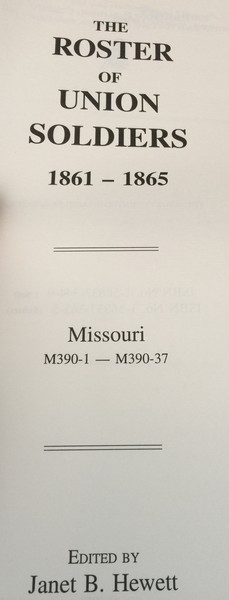
Carnes, James B., Co. 16, 1 Missouri S. M. Cav.
Why was a native of Indiana mustering with a State Militia Cavalry unit in Missouri? I don't know for sure, but it is not so strange once you read about the MMB and their recruitment. Remember: the MMB was headquartered in St. Louis and drew its first units from Missouri. Alfred Ellet, the founder of the MMB, initially was commissioned a captain in the 9th Missouri Volunteer Infantry Regiment, which changed its name to the 59th Illinois Volunteer Infantry Regiment on 12 Feb 1862. The 59th Illinois GenWeb website headline reads:

"59th Illinois Infantry Regiment (Zouaves, part of the Ram Switzerland), Three Year Service"
Many units morphed, dissolved into, or were simply renamed throughout the Civil War. Did the '1st State Militia Cavalry, Co. K' become the 18th Illinois, Co. K? Was the 1st State Militia Cavalry, Co. K also known as the 1st State Militia Cavalry, Co. 16? I have yet to find verification on any of this. If you know, let me know.
As I mentioned before, Bracken did have a family connection to Missouri through his father, Alexander, and younger sister Sarah Jane Carnes Pleasant.
Farragut and the Switzerland
Then-Flag Officer David G. Farragut had not yet made his now-famous command Damn the torpedoes! until after Bracken had finished his enlistment aboard the Switzerland. Farragut had, though, secured New Orleans for the Union by 01 May 1862 and would continue up the Mississippi with an eye on taking the Confederate citadel at Vicksburg. He might've had free and unfettered access to Vicksburg from the lower Mississippi had it not been for the Confederate battery at Port Hudson. Rebel activity was not quelled along the Mississippi after the battles at Memphis and New Orleans as was hoped; guerilla activity sprouted, shifted and concentrated in the Yazoo River Delta, at Vicksburg and along the Red River, the Confederate supply pipeline west of the Mississippi. Farragut realized he needed assistance to take Port Hudson and to choke off Confederate supply lines along the Red.
During this period, the Union brown water navy heaved away from Cairo and began steaming south. They met Confederate resistance at Pea Ridge and Island No. 10, but ultimately prevailed, setting up the meeting in Memphis in June 1862. Once Memphis was won, Union naval strategists envisioned a sort of pincer movement along the Mississippi, with Foote pushing down from the north and Farragut up from the south... plans like that all work out swimmingly on paper and maps.
In early 1863, Farragut requested assistance from Admiral David Dixon Porter in the form of naval combatants then floating near Vicksburg. Porter was unreachable for being in the midst of an expedition in Steele's Bayou. Alfred Ellet, in his absence and without Porter's expressed permission, committed the Lancaster and Switzerland to assist Farragut. Ellet chose his daredevil nephew, Charles Rivers Ellet, planter of the two U.S. flags at Memphis, to command the two rams on their run down river to meet Farragut. They would have to pass the batteries at Vicksburg to do so. In so doing, the Lancaster was hit and sunk and the Switzerland damaged, but not lost. Bracken was not yet aboard the Switzerland.
Upon his return from Steele's Bayou and learning of the loss of the Lancaster and Alfred Ellet's decision to flank his authority, Porter was livid. In order to exonerate himself from any impropriety in meddling in another officer's command, Farragut wrote Porter to smooth things over. He also defended Alfred Ellet. After the fur had flown and fallen, Farragut requested the continued use of some of Ellet's rams to effect a blockade at the mouth of the Red River. Porter agreed and at this point released the Switzerland to Farragut, who found no shortage of employment for the ram on the Red, Black and Ouachita Rivers in Louisiana. The Switzerland would not be brought back into the fold of the MMB until the day after the fall of Vicksburg, 04 July 1863. Bracken is not yet aboard the Switzerland.
Meanwhile, back in Crawford County, IN, the same month as the fall of Vicksburg, Bracken is a captain in the Scott Guards, repelling Hine's Raid into Indiana. At some point his interest was piqued enough to join the MMB and on 15 October 1863, he inked on as a 1st Class Pilot aboard the Switzerland. Exactly when he came aboard I do not know; exactly where he came aboard I know not either, but if I had to guess, I'd say it was at either Cairo or Mound City, IL.
Bracken was on a consolidated list dated June 1863 of persons with Class I status (whatever that is) in the 2nd Congressional District of Indiana and subject to military duty. His brother John was on a similar list, same date, same district, but of Class II status; John is listed as a miller (he did build and operate a mill) and under his remarks is written rheumatism . I have yet to see any record of John as having served during the Civil War. Bracken also had problems with rheumatism the last twenty years of his life, according to medical affidavits in his records.
Oct 1863-64
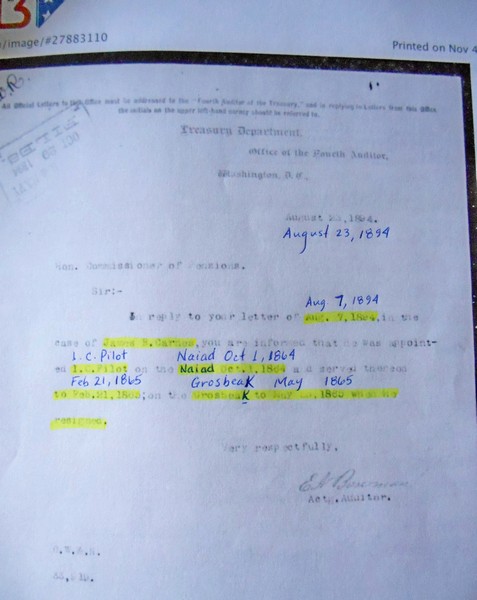
I draw the following time line from Crandall and Newell's book, tracking specifically the movements of the Switzerland , in order to get a better idea of the exact action Bracken saw. I will assume he was confined to the Switzerland's pilothouse in his duties.
When one reads Crandall and Newell's account of MMB activity during this period, one gets the impression of constant movement by the Ram Fleet in support of the MMB: ferrying cavalry up and down the Mississippi, as well as up its major tributaries, to scout, challenge and give chase to two well-known Confederate raiders operating in the Greenville-Vicksburg-Yazoo City triangle, Nathan Bedford Forrest and Wirt Adams. This is what drove the Switzerland's movements in the period of Bracken's first enlistment (15 Oct 1863 - 19 Jun 1864).
Some of the action the Switzerland saw to follow:
October 18: Brig. Gen. John Hawkins pleads for reinforcements from Maj. Gen. James McPherson, then garrison commander at Vicksburg, who sends the Marine Brigade
Oct 21: Admiral Porter receives a dispatch from U.S. Secretary of Navy Welles informing him control of the Marine Brigade will now reside with Grant
Oct 30: Telegram from the Autocrat informing that Charles Rivers Ellet had died at the home of his uncle in Bunker Hill, IL
Late Oct - early Dec, 1863: Maj. Gen. McPherson employs Col. Currie of the MMB with incursions into Mississippi and Louisiana on a mission to seek and destroy Confederate Col. Wirt Adams' cavalry brigade; the MMB's Ram Fleet transports horse marines, artillery, raids rebel supply lines and transports
Dec 17: Switzerland is ordered to Natchez with dispatches to secure more saddles
Dec 21, 1863: Grant writes Rear Adm Porter promising to visit the Mississippi Squadron base at Cairo, IL, and will work in concert with the Navy to stop rebel firing upon Union river transports on the Mississippi, to include a movement up the Yazoo River
(Note: the Mississippi Squadron is not the MMB, rather a different command altogether, but after the capture of Memphis, the Squadron was transferred to the control of the U.S. Navy and the transfer included the U.S. Ram Fleet, by then reconstituted as the MMB)
Dec 26 - Jan 1, 1864: the whole Ram Fleet remains at Grand Gulf, partly for lack of fuel, partly to muster and receive pay
Jan 17, 1864: Grant plans to seize the central part of the state of Mississippi to eliminate the central base of Confederate insurrection creating havoc on Union steamboat traffic, so named the Yazoo Expedition; it is a joint Army-Navy force tasked with the execution of miscellaneous amphibious landings and the 'liberation' of cotton from the Confederacy; cotton bales not employed as barricades aboard troop steamers would be delivered North for conversion into compensation funds
Jan 20: Brigade scouts learn of CSA Gen. Wirt Adams presence in the vicinity of Port Gibson. The Raine, Baltic and Diana are ordered to drop downriver to where the Switzerland was 'wooding up'
Jan 21-25: the whole Ram Fleet lands halfway between Grand Gulf and Bruensburg on the Louisiana side to wood up
Jan 27: The Yawl Expedition (Newell's account): Newell is sent downriver from Grand Gulf at night in a yawl, along with a small contingent, to investigate a Confederate ferry crossing; the Switzerland is designated to pick them up the next morning
Jan 28: The Switzerland picks up Newell's contingent along with two Confederate officers taken prisoner and heads back upriver toward Grand Gulf; two young ladies standing on the river bank hail the Switzerland ashore wanting to exchange butter and eggs for coffee; the Switzerland is stopped and a yawl with Lt. Ed Ellet plus two other officers are sent ashore to oblige the ladies' request; later the same day, the Switzerland comes upon a bar in the river covered with wild geese; the crew had all the fowl they could shoot; roasted goose would be on the Brigade menu for days to follow; flags on all boats were at half mast in honor of the death of Chief Sailing Master Henecks; after delivering Newell, the Switzerland is sent to anchor off of Waterproof Landing
Jan 31: Orders are received for the Ram Fleet to return to Vicksburg, save the Switzerland, which is to cruise between Hard Times and Waterproof Landing until further orders
Feb 15-Mar 10: The balance of the Ram Fleet is ordered downriver below Vicksburg where they are principally employed in locating and securing cotton
Feb 27: From Huntsville, AL, General Sherman issues new orders to Brig Gen Ellet for the MMB; Ellet is to devote his attention and that of his command exclusively to the protection of the 'planting interest' on the Mississippi River between Greenville and Vicksburg; Sherman specifically states the MMB 'is in no case' to proceed north of Greenville or south of Vicksburg
March 10, 1864: "Bank's Red River Expedition": the Ram Fleet is under orders to assemble at Vicksburg and transport troops to the Red River; the Switzerland is assigned to patrol the vicinity of Grand Gulf
March 12: the Ram Fleet moves up Red River into the Atchafalaya and anchors at Simmesport, LA.
Mar 18: Ram Fleet leaves Fort De Russey and reaches Alexandria; while on the Red River the fleet confiscates a considerable amount of sugar and molasses.
Mar 21: Dispatch sent from Lt. Gen. Leonidas Polk (highest Confederate authority in the West) to Confederate President Jeff Davis: plans are being hatched to more systematically conduct raids on navigation of the Mississippi and "such an arrangement would effectually prevent the raids that are now being made from the river by cavalry who go up and down on the river fleet of the enemy under Ellet and would give protection to such our planters as might desire to resume their planting"
Mar 31: Change of command at Vicksburg garrison: Gen. McArthur succeeds Gen. McPherson (perhaps no officer understood the nature and mission of the MMB as much as McPherson and the Marines faithfully executed his orders)
Apr 5: The Monarch and Switzerland return from their trip up the Sunflower River where they had been sent to gather information on the enemy
Apr 6-8: Monarch and Switzerland depart for Yazoo City to gather information on the enemy there
Apr 16: Brig Gen Ellet receives instructions from Gen. McArthur to send the Ram Fleet up to Memphis to report to Gen. Hurlburt for duty
April 28: Gen. Slocum succeeds Gen. McArthur in command at Vicksburg
May 14: Switzerland lands at Yazoo City; her arrival was timely as she rendered valuable assistance, moving with her guns from point to point as needed.
May 15: Union Gen. McArthur arrives at Yazoo City just as Confederate Col. Wirt Adams' command arrives; Capt. Crandall writes this account: "I could tell a strange tale of destitution among the residents... they rush around like mad and try all kinds of schemes with commissaries... the great cry is 'flour-flour, only let us have flour! The women beg, urge and plead for it"
May 16: Two men from the 11th Illinois Volunteers are found hanging in a tree; the citizens show a mean and bitter spirit toward Union soldiers during their stay at Yazoo City
May 18: Preparations are made to return all troops to Vicksburg; the Switzerland would return to Hayne's Bluff
I see no more mention by Crandall and Newell of the Switzerland's movements between May 18 and June 19, the last day of Bracken's enlistment aboard her.
For all I've learned of Bracken, the picture I have of his military life is still grossly incomplete. If there exists a captain's or pilot's log of the Switzerland during the time of Bracken's enlistment, I want to see it. I seek the same for the Tinclads USS Naiad and USS Grosbeak, two ships he piloted in his second enlistment.
Before I go on to his post-war life, I include this entry from Way's Packet Directory of the packet steamer John Swasey, which states it was "owned by a Captain Carnes and named for a venerable Cincinnati merchant. Snagged and lost above Cape Girardeau, MO, August 31, 1864." The John Swasey was built that same year it was lost. Unfortunately, the owner's first name is not listed, so I don't know if this Captain Carnes is of any direct relation to me.
After the war
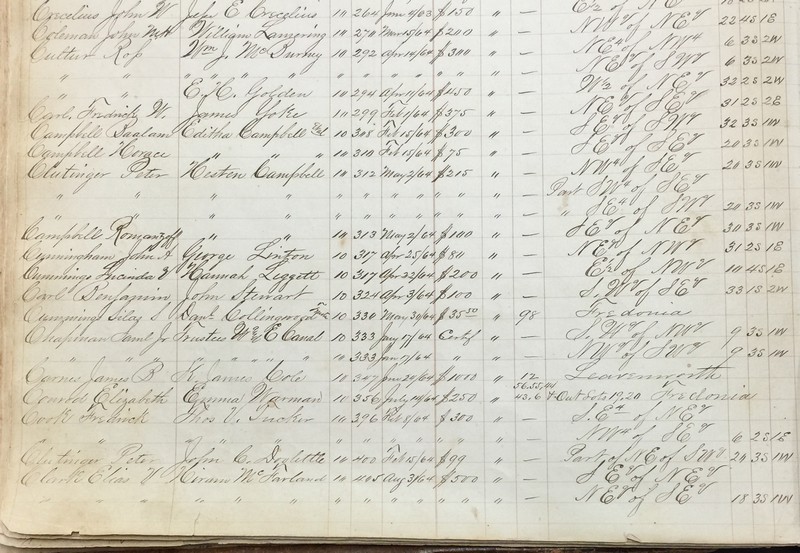
During the decade or so after the war, Bracken looks to be sufficiently invested in Crawford County, according to land deeds:
His first recorded purchase of property was in 1853; he made a purchase in the town of Leavenworth on 24 Jun 1864, five days after the end of his first enlistment; one on 28 May 1865, five days after the end of his second enlistment; on 08 Aug 1869 he bought two sections in the town of Leavenworth from Zebulon Leavenworth, the man who gave Leavenworth its name; another on 01 July 1870 from Zebulon again, for $4540, in Leavenworth; once again he purchased another section from Zebulon on 15 Dec 1870 in Leavenworth; and then he purchased 40 acres in a quarter of the county on 10 Aug 1878. His wife Amanda purchased a plot from Margaret Leavenworth for $5000 on 15 Oct 1872, again in Leavenworth; she made another small land purchase on 01 May 1874.

So, like his father Alexander before him (in Fredonia) and his brother John (all over the county), Bracken owned property, having the wherewithal to do so. Ergo, as I stated earlier, I have no reason to think he entered military service for economic hardship.
The 1870 CC census shows Bracken, his wife and their five children together under the same roof (he listed himself as a "merchant" to the enumerator). The 1880 CC census shows Bracken, Amanda and their five children, a huddle of Hoosiers, still together, presumably happy, but indisputably enumerated under the same roof again.

There are some interesting notations on the 1880 census report: Bracken's father (Alexander) is listed as being from 'Pennsylvania', which runs counter to the apocrypha that he came from Delaware. The state of Delaware was originally carved out of the Pennsylvania colony before gaining statehood (the Episcopalian contingent in Delaware had immediate differences with Quaker William Penn, by the way). In the 1880 CC census Bracken lists himself as a "steamboat pilot"; the Captain Jack of our story, a strapping young man of a mere 19 years in 1880, lists his profession as "Boating".
For all genealogists, the census of 1890 is a problematic one for the simple reason that much of the data from that year was lost to fire and water in the basement of a Commerce Building in Washington DC. Thus, genealogical data from that census is a bit scarce and I'm left to find other documentation hinting at when Bracken and Amanda pulled stakes in Leavenworth and moved to Caseyville, KY.
Marking their moves, connections to place

Bracken, Amanda and their eldest daughter Elizabeth are buried in the Ark Lodge Cemetery just up the hill from Mulfordtown (very near Caseyville), atop a bluff overlooking the Ohio. Also buried at Ark Lodge are Thomas B. Chancellor (d. 1888) and Addie R. Chancellor (d. 1891), both children of Hattie Carnes Chancellor, one of Captain Jack's four sisters. Thomas B. was born and died the same day and dear little Addie didn't live more than a year on Earth before her soul's assumption.
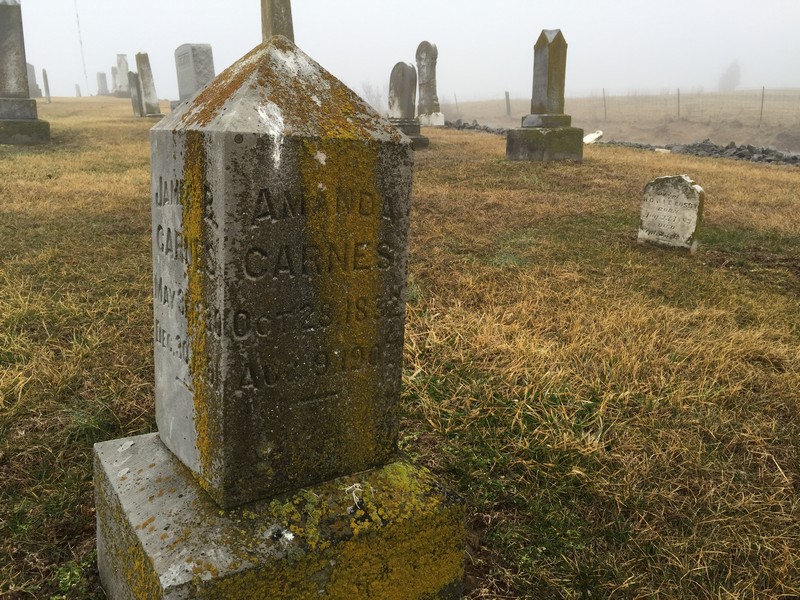
I mention little Thomas and Addie because they were both buried at Ark Lodge while their Grandfather Bracken and Grandmother Amanda were still living, presumably in Mulfordtown/Caseyville. I don't know when Hattie was married, but she did live most of her married life in Sturgis, KY. I can't imagine she would bury her two little lambs of God in cold, unfamiliar ground in Caseyville unless she had some connection to that place. For that reason I'm inclined to think she was living in Mulfordtown/Caseyville when she gave birth to Thomas and Addie, burying them there and keeping their memory nearby .
So, sometime between the Crawford County (IN) census in June 1880 and Thomas B.'s death on 28 Jul 1888 in Caseyville, Bracken and Amanda moved from Leavenworth and settled in Caseyville. I'll also assume within that period, until I learn of her actual marriage date, that Hattie married Thomas M. Chancellor.
Doing the best they could
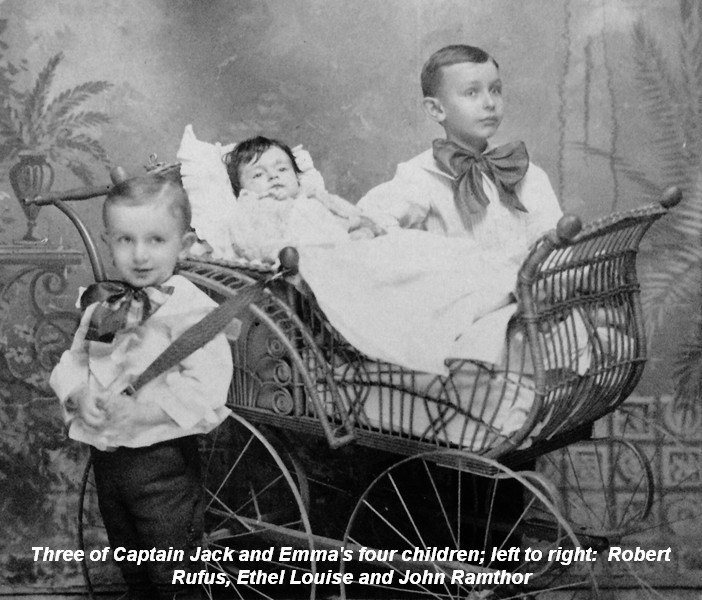
Bracken's pension files list his last service on... .the H.M. Townsend . Way's Towboat Directory lists the H.M. Townsend as being in commercial service, not military. It was built to tow transfer barges at Wheeling but long towed cross ties from the Little Kanawha River to Pittsburgh. His whole life's work considered, I'm left wondering if Bracken was ever home.
I wonder the same about his son. Captain Jack moved to Golconda, IL, by 1889, according to his death certificate, and was married in 1892, a wedding his father was not alive to see. Captain Jack owned his first boat in 1896, the towboat Dick Clyde, running Paducah-Dover along the Cumberland River; he later owned the towboat Woolfolk, running ties out of the Tennessee River. His two sons, John Ramthor and Robert Rufus, were young boys when he passed away in 1903. Captain Jack and his wife Emma had two daughters as well, Ethel Louise and Lorena, but both died in infancy. They are peacefully resting next to their Mom and Dad in Golconda.

After Bracken's death, his widow Amanda lived for a time in a house on a small lot in Mulfordtown, (possibly where they once lived together), appraised at $150 in 1892. Affidavits written on her behalf, upon her appeal for being taken off the Navy widows' pension roll, say she had no income and was wholly dependent on her own labor for support.
A note: Bracken was considered a civilian contractor , not a U.S. Navy sailor, according to Department of Treasury and Bureau of Pensions correspondence in his records. In spite of such administrative segregation, I don't see where that designation created a problem for him being granted a Navy Invalid pension for himself. Conversely, his 'civilian contractor' designation would be the reason why widow Amanda was rejected for a Widow's pension, it stating that because he was not considered real Navy, she did not meet the definition of a Navy widow.

What happened to all that property they owned in Crawford County? Did they sell it before they left? Why was Amanda so destitute at the end of her life as her appeal suggests? Her son was still alive and evidently had enough money to invest in steamboats. And at least one of her daughters, Hattie, was just one town over in Sturgis. Belle Z, her youngest child, was still alive, but I don't know much about her financial situation. The documents I have on Amanda's Belle Z say that Belle Z (a nickname for Isabel, I believe) spent some years in Bantry, ND, around 1925 with a man by the name of Sheffer or Shafer (spellings vary; Belle's headstone reads 'Sheffer'). Just when she moved there and when she moved back to Kentucky, I don't yet know. Amanda's other living daughter between the time of Bracken's death and Amanda's own death, Kate Carnes Stanard, shows up in the Casper, WY, census of 1910 with three children, all born in Marsland, NE. The father of Kate's children is a man from Michigan, no first name given. I've a hunch it is Almon Stanard, but I have yet to find the documentation to cinch that hunch. Almon was buried at Marsland, NE.
When I first told my own mother, Marlys Rae Lund Carnes, about Bracken and Amanda and where they lived, so close to the river in Caseyville, she said, Why, she could have waved hello with her kitchen apron at her husband or son passing by on a steamboat.
Bracken spent the last 14 days of his life in the U.S. Marine Hospital in Cairo, IL, passing away on 30 December 1891, while battling influenza complicated with pneumonia.
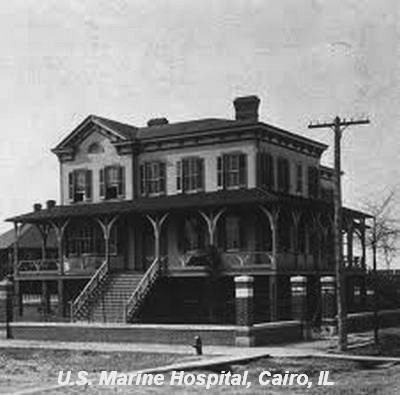
Ironic endings
I've talked quite a bit about the varied service Bracken rendered during the Civil War for the Union's cause. Today, when one enters Caseyville on the road from Sturgis, an historic marker greets you. I'll quote the inscription on the marker:
Every inhabitant of this pro-southern town was taken prisoner by the crew of a Union gunboat, 26 Jul 1862. All were released except 19 men who were taken to Evansville, IN, as hostages to guarantee payment of $35,000 in damage done by Rebel guerillas.
How ironic that a Yankee partisan such as Bracken would choose to live out the august years of his life in a town with such a history! Caseyville was an important commercial town at one time. Ulysses Grant's wife was related to a family in Caseyville. As an important river port, Caseyville attracted the attention of both Union and Confederate units operating in the area.
It might never have been known
Warren Crandall and Isaac Newell were two officers who served in the MMB. They together became the seminal biographers of Ram Fleet and Mississippi Marine Brigade history. They published their book about these two units in 1907 (see biblio). Had it not been for their efforts in consolidating the records, correspondence and diaries pertinent to the memory and efforts of the men of these two units, our knowledge of their contributions would be confused, if not non-existent. This could be said of any group of men in any unit in any war in any epoch.
I am personally appreciative of Crandall and Newell's efforts, not just because ancestors of mine were involved in the units they wrote about, but because they have made an important contribution to the American public record. Accomplished authors such as Hearn and Smith (see biblio) benefited from Crandall and Newell's efforts, as I have benefited from Hearn and Smith's.
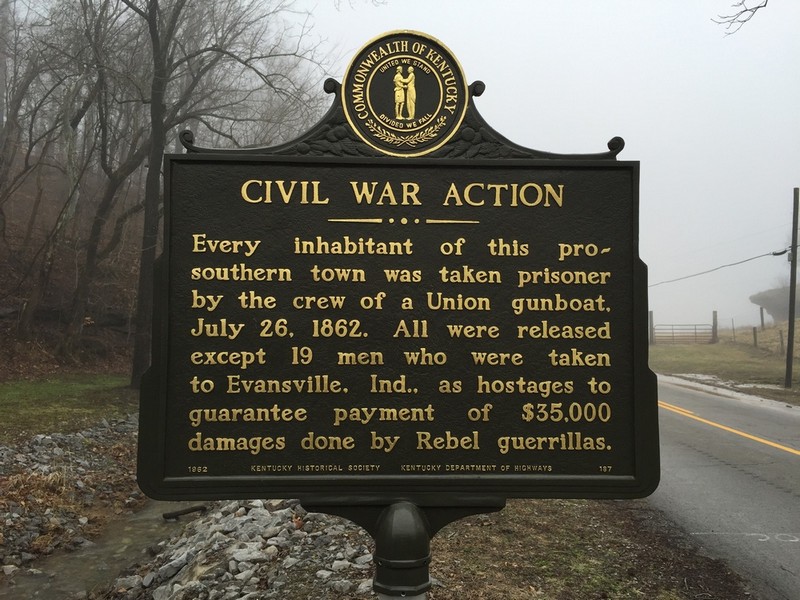
The administrative death knell of the MMB as a distinct command came with Special Order No. 86, issued on 03 Aug 1864 by Major Gen. E.R.S. Canby, commander of the Department of West Mississippi, headquartered in New Orleans. The pith of it, so dry and anticlimactic for such a saucy unit, reads like this:
The enlisted men whose unexpired term of service will justify it will be sent back under suitable conduct to the regiments from which they were transferred and those who have but a short period to serve will be assigned to garrison duty at Vicksburg and will be attached for the remainder of their term of service to regiments of batteries serving at that place
And with the stroke of a pen, poof!, the MMB was dissolved. Bracken's enlistment aboard the Switzerland ended about two months before the dissolution of the MMB and he would be back in service on 01 Oct 1864 aboard the Tinclads USS Naiad, transferring later to the Tinclad USS Grosbeak. You'll remember earlier I mentioned that Charles Ellet, Jr. created a special six-month 'Military Obligation' for his civilian recruits to the Ram Fleet. The nature of Bracken's second enlistment doesn't hint at the same forced circumstances many of the MMB soldiers faced upon the dissolution of the MMB, so I lean toward the notion he joined the MMB under a shorter-term agreement.
It fell to Captain Warren D. Crandall upon dissolution, in his office as Brig. Gen. Ellet's Assistant Adjutant General of the Brigade, to turn over all the records, books, papers and property of the office to the Adjutant General of the District of Vicksburg for transmission to Washington . In later years it was learned that these important records and documents never reached their destination... they were probably regarded as unimportant and in the office changes so frequently occurring were lost sight of and later destroyed... the want of these records had made difficult all efforts of the survivors of the crews of boats in presenting claims to the department and in some instances the character and even names of the boats of the Brigade have been called into question.
Visit page 43 of Bracken's files with me:
Declaration for Invalid Pension (not very legible):
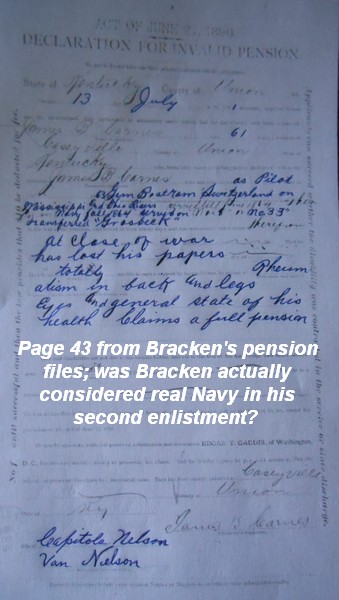
James B. Carnes who was enlisted as a Pilot, Gunboat Ram Switzerland on Mississippi and Ohio Rivers, served till June 1864; then in Navy, Fall 1864, served on Naiad or No. 53 ; transferred Grosbeak in the war of the rebellion and served at least ninety days and was Honorably Discharged there from at close of war; has lost his papers; he is totally unable to care or support by manual labor by reason of rheumatism in back and legs, eyes and general state of his health; claims a full pension
Read the second line with me again: "then in Navy"
This wording suggests to me that Bracken was real Navy in his second enlistment, not just a civilian contractor as he was considered in his first enlistment. If so, Amanda would have been a Navy widow. Was she wrongly dropped from the Navy's pension roll just to save on the $8/month pension then being proffered? Is Amanda King Carnes owed monetary restitution from the date of Bracken's death until her death in 1907?
A plea to the Commander-in-Chief
What I'm about to share with you might or might not have had direct impact on Bracken, but I wanted to include this segment to give the reader an indication of President Lincoln's awareness of the MMB's plight upon dissolution and how he handled it.
Crandall and Newell re-count a meeting between James H. Purdy, a former war veteran from New York turned lawyer, who established a law practice in Vicksburg and represented some of the former MMB soldiers, then doing garrison duty at Vicksburg, in resolving their respective contracts of service.
It's never easy to gain audience with the President of the United States, let alone during a critical juncture in the war, but Lincoln, as Commander-in-Chief, found time to hear out Purdy's plea as he articulated the grievances of the now-dissolved unit. Purdy described Lincoln as looking haggard and cadaverous, as if he was carrying the whole weight of the Nation's burdens upon his shoulders and his heart to suffer all the people's sorrows . I quote further from their book:
Purdy presented their case as briefly, strongly and comprehensively as I could... how these men had served with their regiments in the field, many of them for near full term of enlistment and from wounds or sickness having been sent to convalescent camps throughout the States, were induced to take discharge from their old regiments and to re-enlist in the Marine Brigade... the sole purpose of their new service... to keep the Mississippi and its tributaries clear of rebel guerillas and secure to the public for the safe and free navigation of these great highways... he showed original printed posters which had been put up in the various camps by the others when recruiting for the brigade, recounting all those and other things as inducements to the convalescent soldiers to take discharge and re-enlist for three years in the Marine Brigade
Lincoln interrupted Purdy:
Major Purdy, from your own service as a soldier you are presumed to be loyal, and in common with us all to desire above all things the early triumph of the Union armies. Now, at this time, the darkest hour in our Nation's history, do you think you are serving your country well in urging the discharge of over a thousand soldiers now serving at the front when we need them so badly?
Purdy answered:
Mr. President, I am simply a messenger bearing direct to you the petition of these men who are ready to accept your decision whatever it may be.
Lincoln then summoned Assistant Secretary of War Charles Dana to come to the White House, and look into the President's inquiry into the organization and status of the Marine Brigade
Lincoln continued:
From what Major Purdy has said and shown me it seems to be a question whether we can rightfully hold these men longer in the service now that the Marine Brigade is dissolved. We must keep faith with the men who have fought and are fighting our battles and our promises to them must be sacredly fulfilled. I can not now decide this case. Please take all these papers and Mr. Purdy will go with you and make his statements. Examine them fully and report to me as early as you can your opinion and if these men ought to be discharged they must be without delay, otherwise they must be pushed to the extreme front where now they are so much needed.
Here is Crandall and Newell's closing thought:
What other commander-in-chief of the armies and navies of our country or of any other nation in my age, in face of war's necessities, would have stopped to consider so studiously the rights of the soldier, to carefully weigh them on the scales of justice, what other great war captain in history would have hesitated under the circumstances to deny the petitions and probably to arrest the advocate and punish the petitioners for mutiny?
Purdy called on the White House every day after his meeting with the President to see if he had come to a decision about the fate of MMB soldiers. Several times he was rebuffed. Finally, after three weeks, Assistant Secretary of War Dana (Stanton was ill at the time) received Purdy. He asked Purdy when he would be returning to Vicksburg. Purdy said as soon as he received word of the President's decision. Dana then handed him an official letter and said he could return to Vicksburg tonight for Mr. Lincoln had ordered the final discharge of the Marine Brigade.
|